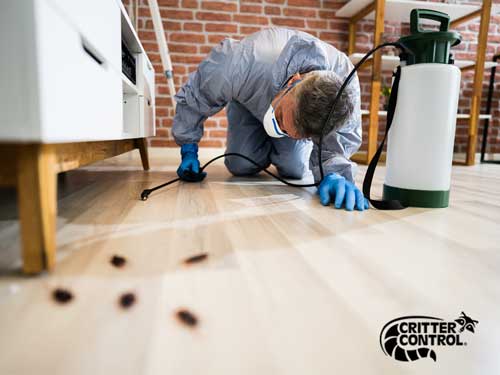Reliable A1 Bed Bug Treatment in Charlotte - Safe and Proven Approaches
Wiki Article
Bed Insect Therapy Malfunction: Comparing Chemical Vs. Non-Chemical Solutions
In the world of pest control, specifically when taking care of the consistent issue of bed pests, the selection in between chemical and non-chemical treatment options can be a crucial one. Both strategies offer distinct advantages and downsides, affecting factors such as efficiency, security considerations, and general cost. By analyzing the nuanced information of each technique, a more clear understanding of which course to seek in resolving a bed pest infestation can be achieved.Efficiency of Chemical Treatments
Chemical treatments for bed insect problems have actually been widely recognized for their fast and powerful efficiency in eliminating these parasites. When taking into consideration the effectiveness of chemical treatments, it is vital to comprehend that they can give a quick and thorough solution to a bed pest problem. Specialist pest control specialists usually depend on pesticides to target bed pests at various stages of their life cycle, including grownups, nymphs, and eggs. These chemicals typically function by interfering with the bed bugs' nerves, resulting in paralysis and ultimate fatality.In addition, chemical treatments have the advantage of providing residual results, meaning that they can remain to eliminate bed pests also after the first application. This recurring activity is especially helpful in combating any type of potential re-infestations. In addition, the rapid activity of chemical treatments can bring alleviation to individuals facing extreme bed pest infestations, permitting them to gain back control of their home swiftly.
Security Interest In Chemical Solutions
One critical element that requires mindful consideration when utilizing chemical remedies for bed bug therapy is making certain the security of occupants and the environment. Exposure to certain chemicals utilized in bed pest treatments can lead to respiratory issues, skin irritability, or various other negative reactions, especially in people with pre-existing problems or level of sensitivities.Additionally, the ecological effect of chemical options is another substantial factor to consider. Some chemicals used in bed insect treatments might be unsafe to helpful insects, wildlife, and communities if they seep right into the dirt or water supply. It is necessary to utilize chemical treatments judiciously, complying with safety and security standards, and taking into consideration less hazardous options to alleviate these threats and ensure the reliable and risk-free administration of bed insect infestations.
Benefits of Non-Chemical Methods
Considering the prospective security issues and ecological impact connected with chemical remedies for bed insect therapy, checking out non-chemical techniques presents an encouraging option with a number of distinct benefits. Non-chemical treatments are environmentally pleasant, as they do not contribute to air or water pollution, making them a lasting choice for pest control.Additionally, non-chemical options can be reliable in targeting bed bugs, including hard-to-reach locations where chemical therapies may not penetrate - A1 bed bug exterminator charlotte. Methods such as warmth treatment, vacuuming, heavy steam cleansing, and mattress encasements give detailed elimination without the use of harmful chemicals.
Limitations of Non-Chemical Treatments

Furthermore, non-chemical therapies often need several applications to attain successful removal. This can be taxing and might not cockroach control always ensure total removal of all bed bugs and their eggs, especially in covert or hard-to-reach places.
In addition, the success of non-chemical treatments heavily depends on correct execution and thoroughness, which can be challenging for individuals without expert competence. Poor application of non-chemical approaches may result in incomplete removal, bring about persistent infestations and the requirement for extra treatments.
As a result, while non-chemical therapies have their advantages, it is necessary to recognize these limitations and consider them when figuring out one of the most efficient strategy for taking care of bed pest infestations.
Cost Contrast: Chemical Vs. Non-Chemical Options
Given the restrictions linked with non-chemical treatments, an essential element to evaluate in the context of bed insect monitoring is the cost contrast in between chemical and non-chemical options. In comparison, non-chemical therapies like heat therapy or vapor can be more costly, with prices ranging from $1,000 to $6,000 for an entire home. While the preliminary expense of chemical treatments may seem reduced, multiple treatments may be called for to fully remove the problem, possibly enhancing the total price.Conclusion

Thinking about the possible security concerns and ecological influence linked with chemical solutions for bed bug therapy, exploring non-chemical methods provides an encouraging option with several distinct advantages.Provided the constraints linked with non-chemical therapies, an essential facet to examine in the context of bed pest management is the cost click to find out more comparison between chemical and non-chemical options. In contrast, non-chemical treatments like warm treatment or heavy steam can be a lot more pricey, with prices varying from $1,000 to $6,000 for an entire home. While the initial expense of chemical therapies might seem lower, several therapies might be called for to fully get rid of the invasion, potentially boosting the general cost.In verdict, when comparing chemical and non-chemical bed pest treatment choices, it is essential to think about efficiency, safety, benefits, constraints, and expense.
Report this wiki page